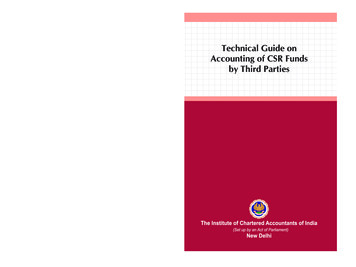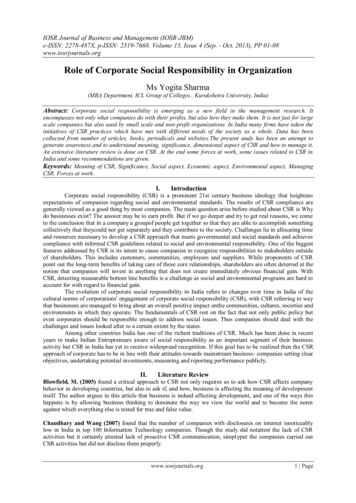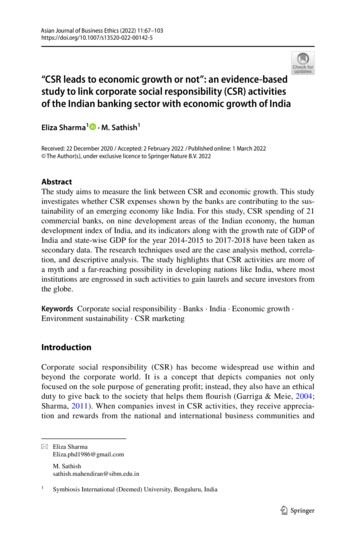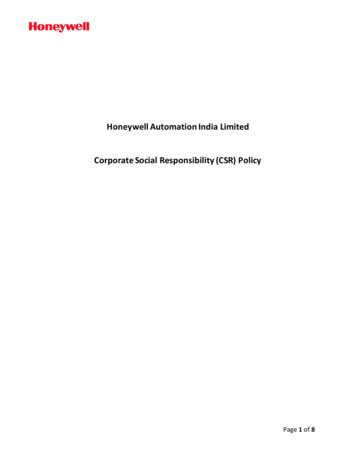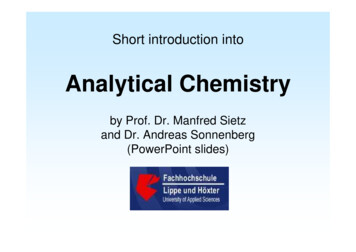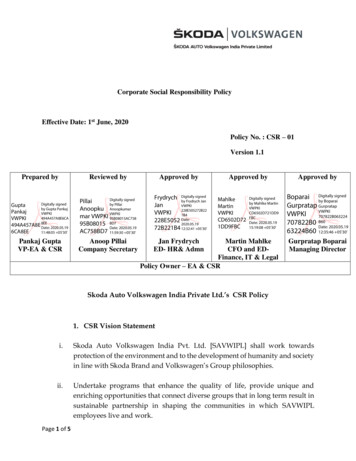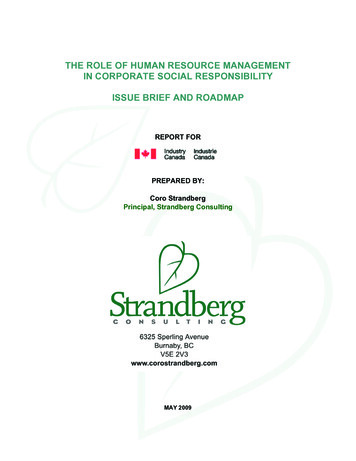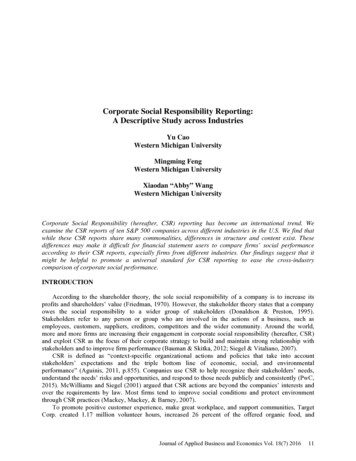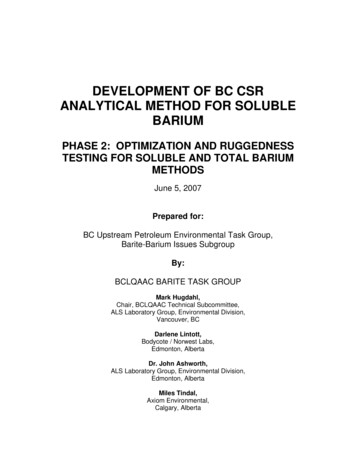
Transcription
DEVELOPMENT OF BC CSRANALYTICAL METHOD FOR SOLUBLEBARIUMPHASE 2: OPTIMIZATION AND RUGGEDNESSTESTING FOR SOLUBLE AND TOTAL BARIUMMETHODSJune 5, 2007Prepared for:BC Upstream Petroleum Environmental Task Group,Barite-Barium Issues SubgroupBy:BCLQAAC BARITE TASK GROUPMark Hugdahl,Chair, BCLQAAC Technical Subcommittee,ALS Laboratory Group, Environmental Division,Vancouver, BCDarlene Lintott,Bodycote / Norwest Labs,Edmonton, AlbertaDr. John Ashworth,ALS Laboratory Group, Environmental Division,Edmonton, AlbertaMiles Tindal,Axiom Environmental,Calgary, Alberta
Table Of Contents1.0INTRODUCTION. 42.0PHASE 2 OUTLINE AND OBJECTIVES. 53.0EXPERIMENTAL METHODOLOGY . 73.1PREPARATION OF TEST SOILS . 73.2PHASE 2A - CALCIUM CHLORIDE EXTRACTION METHOD . 83.3PHASE 2B - STRONG ACID AND TOTAL BARIUM TEST METHODS . 93.3.1US EPA 3050B . 93.3.2BC Strong Acid Leachable Metals (SALM). 103.3.3Fusion - X-Ray Fluorescence (Fusion-XRF) . 113.4PHASE 2B BARIUM METHOD SIDE STUDIES . 112b-1. Acid Volume to Soil Mass Ratios . 122b-2. Acid Strength . 122b-3. Digest Hold Time and Temperature . 122b-4. Effect of Final Dilution of Digest for ICP Analysis . 122b-5. Solubility of Barite in CaCl2 and Strong Acid. 132b-5a. Solubility of Barite in Calcium Chloride . 132b-5b. Maximum Recovery of Barium from Pure Barite in Strong Acid Digests 132b-6. Sample Weight. 142b-7. Salt Concentrations in Soil . 144.0RESULTS AND DISCUSSION. 154.1PHASE 2A - OPTIMIZATION OF CALCIUM CHLORIDE EXTRACTIONMETHOD. 154.3BARIUM METHOD SIDE STUDIES . 202b-1. Acid Volume . 202b-2. Acid Strength . 202b-3. Digest Hold Time and Temperature . 222b-4. Effect of Final Dilution of Digest . 232b-5. Solubility of Barite in CaCl2 and Strong Acid. 232b-5a. Solubility of Barite in Calcium Chloride . 232b-5b. Maximum Recovery of Barium from Pure Barite in Strong Acid Digests 232b-6. Sample Weight. 232b-7. Salt Concentrations in Soil . 232b-7a. BC Soluble Barium. 232b-7b. BC SALM Barium . 232b-7c. EPA 3050 Barium. 235.0RECOMMENDATIONS AND CONCLUSIONS . 236.0REFERENCES. 23Appendix 1. Detailed Characterization of Background Soils. 23Appendix 2. Phase 2a Results: Calcium Chloride/Total Barium Methods . 23Appendix 3. Phase 2b Data Tables . 23Appendix 4. Phase 2b Side Study Data Tables (mg/kg) . 23Appendix 5. Phase 2b-7SS Data Tables . 49Phase 2 Optimization of Soluble and Total Barium MethodsBCLQAAC Barite Task Group, June 5, 2007.Page 2 of 53
List of TablesTable 1. Primary Characteristics of Background Soils . 8Table 2. Measured Barium by BC Soluble Barium (1.0 M CaCl2) in Chloride and SulfateSpiked Sand and Clay. 23Table 3. Measured Barium by BC SALM Total Barium in Chloride and Sulfate SpikedSand and Clay. 23Table 4. Measured Barium by EPA 3050 Total Barium in Chloride and Sulfate SpikedSand and Clay. 23Table 2a-1. Barium Chloride in Sand . 23Table 2a-2. Barium Chloride in Clay . 23Table 2a-3. Barium Sulfate in Sand . 23Table 2a-4. Barium Sulfate in Clay . 23Table 2b-1. Barium Sulfate in Sand . 23Table 2b-2. Barium Sulfate in Clay . 23Appendix 4. Phase 2b Side Study Data Tables . 23Table A5-1. Barite Solubility in CaCl2 . 23Table A5-2. Chloride Spiked Sand. 23Table A5-3. Sulfate Spiked Sand . 23Table A5-4. Chloride Spiked Clay . 23Table A5-5. Sulfate Spiked Clay . 23List of FiguresFigure 1. Recovery of Spiked Barium Using Total Ba Methods . 16Figure 2. Calcium Chloride Extractable Barium . 17Figure 3. Calcium Chloride Extractable Barium . 18Figure 4. Phase 2b Recovery of Spiked Barium Using Total Barium Methods. 19Figure 5. Barium Recovery in Sulfate Spiked Soils with EPA 3050B. 21Figure 6. Barium Recovery in Sulfate Spiked Soils with BC SALM . 22Figure 7. Effect of Hold Time and Temperature of Digest on Barium Recovery . 23Figure 8. Barite Solubility in Calcium Chloride Extractions . 23Figure 9. BC Soluble Barium in Chloride and Barium Spiked Sand. 23Figure 10. BC Soluble Barium in Sulfate and Barium Spiked Sand. 23Figure 11. BC Soluble Barium in Chloride and Barium Spiked Clay. 23Figure 12. BC Soluble Barium in Sulfate and Barium Spiked Clay . 23Figure 13. BC SALM Barium in Chloride and Barium Spiked Sand. 23Figure 14. BC SALM Barium in Sulfate and Barium Spiked Sand . 23Figure 15. BC SALM Barium in Chloride and Barium Spiked Clay . 23Figure 16. BC SALM Barium in Sulfate and Barium Spiked Clay . 23Figure 17. EPA 3050B Barium in Chloride and Barium Spiked Sand . 23Figure 18. EPA 3050B Barium in Sulfate and Barium Spiked Sand . 23Figure 19. EPA 3050B Barium in Chloride and Barium Spiked Clay . 23Figure 20. EPA 3050B Barium in Sulfate and Barium Spiked Clay . 23Phase 2 Optimization of Soluble and Total Barium MethodsBCLQAAC Barite Task Group, June 5, 2007.Page 3 of 53
1.0INTRODUCTIONThe British Columbia Ministry of Environment is currently developing matrix numericalsoil standards for barium. Barium soil standards will impact the operations of the BC oiland gas sector, because barite (barium sulfate) is regularly used as a weighting agentfor drilling muds. The BC Upstream Petroleum Environmental Task Group – BariteBarium Issues Committee was formed to provide an inter-governmental and industryexpert advisory body for collaboration on scientific and technical aspects needed tosupport the development of barium standards. Government representation on the BariteBarium Issues Committee includes BC MOE, the BC Oil and Gas Commission, and theBC Ministry of Energy, Mines, and Petroleum. Axiom Environmental and the TechnicalSub-Committee of the British Columbia Laboratory Quality Assurance AdvisoryCommittee (BCLQAAC) are represented on the committee in a scientific advisorycapacity.Because of the extremely low aqueous solubility and low toxicity of barite, the BariteBarium Issues Committee is recommending that BC develop and endorse an analyticalmethod for soluble barium for use by the Oil and Gas sector of BC at sites wheredetailed documentary evidence of barite usage exists. An appropriate analytical methodfor soluble barium should generate relatively low results for barite-barium in soils, butquantitative or near-quantitative results for more toxic forms of barium with higheraqueous solubilities and mobilities than barite (e.g. barium chloride, barium acetate),unless they are strongly sequestered onto soil cation exchange sites.Prior to endorsing the regulation of soluble barium, BC MOE requires that developmentand validation of an appropriate method be conducted to ensure that it will beenvironmentally relevant and sufficiently protective for soluble forms of barium wherethey may be present.The BCLQAAC Technical Subcommittee was tasked with the development andvalidation of a suitable analytical method for the determination of soluble barium in soilsand solids. A task group was formed for this purpose, consisting of Mark Hugdahl(Chair, BCLQAAC Technical Sub-committee, ALS Laboratory Group), Darlene Lintott(Bodycote/ Norwest Labs), and Dr. John Ashworth (ALS Laboratory Group). MilesTindal (Axiom Environmental) also participated in an advisory capacity.The BC CSR soluble barium method development project is being conducted in threestages: Phase 1: Evaluation of Viable Soluble Barium Analytical Methods Phase 2: Optimization and Ruggedness Testing of Analytical Method for SolubleBarium Phase 3: Interlaboratory Testing of Analytical Method for Soluble BariumPhase 1 investigations assessed various candidate soluble barium methods for theirefficacy and recovery when applied to barite impacted soils of various textures. Theseinvestigations established the primary candidate for a soluble barium method as aCalcium Chloride extraction method. This method is based on the calcium chlorideextraction method that is prescribed by Alberta Environment for their regulation ofsoluble barium. Recommendations for further work identified by the Barite-BariumPhase 2 Optimization of Soluble and Total Barium MethodsBCLQAAC Barite Task Group, June 5, 2007.Page 4 of 53
Issues Committee and the BCLQAAC Barite Task Group included evaluating solublebarium recoveries with the selected method using coarse textured soils with higherconcentrations of barite (as would actually be encountered at drilling waste sites), todetermine whether there is an upper ceiling for soluble barium by these techniques, andwhat it may be. The Phase 1 report also recommended that any optimized methodshould also be more extensively evaluated with more soluble forms of barium than barite(e.g. barium chloride), which would likely be necessary to establish a CSR standard forsoluble barium by the method.Total barium methods were also evaluated in Phase 1 work. Results suggested thatthere is likely an upper limit of barite that can be measured using acid digestion methodssuch as the BCSALM or EPA 3050, and that this limit may have an impact on whetheran acid digest method could be used to accurately characterize the true total bariumconcentration at a barite site. It was also established that small differences in methodprocedures can have a strong impact on barium recovery from soil. The use of anumeric regulatory standard for total barium in soil demands that laboratory results arecapable of capturing consistent, replicable soil recoveries of barium that represent truesoil concentrations, over a range of concentrations which may occur at typical drillingwaste sites.The recommended course of action for further investigations included examining thecorrelation of strong acid digestion barium recoveries versus true total bariumconcentrations, and evaluating the impact of procedural modifications to total bariumtechniques. Variables suggested for consideration included digestion temperatures,times, acid:solid ratios, and other potentially significant method variables.This report documents Phase 2 of the project.2.0PHASE 2 OUTLINE AND OBJECTIVESPhase 2 of the project was divided into 2 components:2a. Optimization of Calcium Chloride Extraction Method for Soluble Barium2b. Detailed Evaluation of Methods for Total Barium.The primary objective of the first component of the study was to refine the CalciumChloride extraction method to optimize its effectiveness at distinguishing betweensoluble and insoluble barium in two contrasting soil textures. It is important to note thatthe intent of a soluble barium method is to be able to discriminate between soluble andinsoluble forms of barium. Thus an ideal method for soluble barium will achievequantitative or near quantitative recovery of soluble and mobile forms of barium ,with amuch lower recovery of barite barium.The candidate soluble barium method was established in Phase 1 and was based on theAlberta Environment Barite Guidelines calcium chloride extraction method. Theintended principle behind the AENV soluble barium method is that an increasedconcentration of barium in the extraction solution occurs because barium cations that aresorbed to the soil can be solubilized when excess calcium ions exchange with barium(and other cations) on the cation exchange sites of clay particles. The cation exchangemechanism should have minimal effect on insoluble barite salts, which should notPhase 2 Optimization of Soluble and Total Barium MethodsBCLQAAC Barite Task Group, June 5, 2007.Page 5 of 53
interact with cation exchange sites because they are uncharged (unless they becomesolubilized).It was recognized from Phase 1 work investigations that the concentration of calciummay increase the recoveries of soluble barium from soils with a higher cation exchangepotential. This work was continued in this phase of the study by investigating the impactof increasing the calcium chloride concentration in the extraction solvent on severalconcentrations of barium spiked soils.The Phase 2a study consisted of a laboratory evaluation of the proposed soluble bariumcalcium chloride extraction method using differing strengths of extraction solvent and twotypes of barium spiked field soils. Total barium methods were also included forreference. After completion of Phase 1 studies, the barite subcommittee decided toestablish the solvent:soil ratio at 10:1, which is the ratio used in the Alberta Environmentmethod for soluble barium.The Phase 2a study design was as follows: 6 analytical methods:o Extraction using CaCl2 at ionic strengths of 0.1, 0.5 and 1.0 Mo Total barium methods EPA 3050, BC SALM and fusion-XRF 2 soil types: sandy soil and clay soil 2 spiked barium species: insoluble barium sulfate and soluble barium chloride 4 spiked barium concentrations; 0, 2000, 10000 and 50000 mg/kg as Ba 2 replicates per treatmentAn additional study component in Phase 2a included evaluating the impact of extractionhold time and temperature on soluble barium recovery. This side study was included todetermine if these variables would be significant as a source of interlab variability and/orcause for reduced recovery, and therefore would require prescribed procedures in therecommended method.The second component of the Phase 2 study consisted of a laboratory evaluation of totalbarium methods, including the acid digest methods EPA 3050B and BC SALM. FusionXRF was also included for comparison. The objective of Phase 2b was to determine theupper practical concentration (if any) at which BC SALM and EPA 3050B can effectivelymeasure total barium concentration in barite samples by comparing BC SALM, EPA3050B and fusion-XRF analyses over a range of spiked barite concentrations.The Phase 2b experimental design agreed to by the committee included: 3 analytical methods:o Total barium acid digest methods BC SALM and EPA 3050,o Fusion-XRF 2 soil types: sandy soil and clay soil 1 spiked barium species: barium sulfate 7 spiked barium concentrations; 0, 100, 300, 1000, 3000, 10000, and 100000mg/kg as Ba 2 replicates per treatmentPhase 2 Optimization of Soluble and Total Barium MethodsBCLQAAC Barite Task Group, June 5, 2007.Page 6 of 53
Acid digest methods were performed as prescribed by the reference method, usingmandatory requirements, or minimum requirements where performance basedprocedures were prescribed.Additional side studies were conducted in Phase 2b to investigate the significance ofseveral key variables associated with the acid digest methods on the recovery of bariumfrom spiked soils. It had been established in Phase 1 that small changes in procedurescould have an impact on measured barium concentrations. The degree of impact onbarium recovery from each of these variables needed to be resolved in order to establishpotential for interlaboratory variability, and to determine whether additional mandatoryelements were required in future analytical method protocols.The Phase 2b key variables investigated for their effects on barium recovery from twospiked soils of differing textures using EPA 3050B and BC SALM included:2b-1. Acid Volume Ratios2b-2. Acid Strength2b-3. Digest Hold Time and Temperature2b-4. Effect of Final Dilution of Digest2b-5. Solubility of Barite in CaCl2 and Strong Acid2b-6. Sample Weight2b-7. Salt Concentrations in Soil3.0EXPERIMENTAL METHODOLOGY3.1PREPARATION OF TEST SOILSTwo barite-spiked background reference soils were prepared for analysis for Phase 2aand 2b investigations. The background reference soils included sandy soil (“sand”) andclay soil (“clay”). These soils were provided by Husky and were collected from sites asbackground samples and have likely not been exposed to industrial contaminants.These same soils were also used for investigations completed in Phase 1. The soilswere dried and ground, then spiked with drilling-mud grade barite or laboratory gradebarium chloride dihydrate at the required concentrations (spiked barium concentrationswere in addition to background barium concentrations).These soils were characterized extensively for physical and chemical parameters(presented in Appendix 1). Key characteristics of the two soils that are most pertinent tobarium methods are provided in Table 1.Phase 2 Optimization of Soluble and Total Barium MethodsBCLQAAC Barite Task Group, June 5, 2007.Page 7 of 53
Table 1. Primary Characteristics of Background SoilsParameter 59.4CECmeq/100g1.324.6Barium (EPA 3050B)mg/kg64333Extractable Bariummg/kg9.41.1Sulfate-Smg/kg3.41,120The soils were prepared by drying at 30 C, then disaggregating to 2 mm (but were notpulverized or sieved). Soils were spiked with a supply of barite (Canamara UnitedSupply, provided by Newalta) that is commonly used in drilling muds. For Phase 2a,soils were also spiked with laboratory grade barium chloride dihydrate, added directly tothe dry background soils to achieve the required target concentrations (mg/kg asbarium) above background barium levels. The barium background levels in these soilsare given in Table 1. The spiked dry soils were mixed using end-over-end rotationovernight. The soils were then hydrated with deionized water to achieve a saturatedpaste, in order to allow for soil chemical and physical interactions to occur. Thehydrated soils were allowed to equilibrate for 24 hours, then were dried at 30 C. Thedried soils were disaggregated to pass through a 2mm sieve, then separated into tworeplicate samples per treatment. Treated soils were stored at room temperature.3.2 PHASE 2A - CALCIUM CHLORIDE EXTRACTION METHODThe Alberta Environment extraction methodology for soluble barium in soils may besummarized as follows. The sample is prepared by air drying and sieving to 2 mm. 5 gof prepared sample is added to 50 mL of 0.1 M calcium chloride solution, and is agitatedfor 2 hr on a platform shaker or end-over-end rotator. The extract is filtered to yield aclear filtrate, ready for analysis. After appropriate dilution, samples are analyzed forbarium by ICP.Barium chloride and barium sulfate spiked sand and clay were extracted using theAlberta Environment soluble barium method, with modified calcium chlorideconcentrations of 0.1, 0.5 and 1.0 M. One of each replicate of each treatment describedincluded in the Phase 2a study design was analyzed by this same extraction method byBodycote/Norwest Labs and ALS-Edmonton.As a side study, the impact of hold time and temperature on barium recovery by thecalcium chloride extract was examined by extraction of selected samples of bariumsulfate and barium chloride spiked sand and clay, using 0.1 M calcium chloride. Eachextract was divided into 5 aliquots. One was analyzed the same day the extraction wasperformed. Two of the aliquots were stored at room temperature, then analyzed on day 3and 7 after extraction. The remaining two aliquots were refrigerated (4 C) and analyzedfor barium seven days after extraction.Phase 2 Optimization of Soluble and Total Barium MethodsBCLQAAC Barite Task Group, June 5, 2007.Page 8 of 53
Total barium methods BC SALM and EPA 3050B were analyzed on Phase 2a samplesby NWL using mandatory elements of the respective procedures. Fusion-XRF analysiswas performed on the same samples by ALS-Chemex. These methods are described insections 3.3.3.3PHASE 2B - STRONG ACID AND TOTAL BARIUM TEST METHODSThree methods for measuring total or strong acid extractable barium were included inthis study. The US EPA 3050B Method is a strong acid digestion method, followed byICP analysis. It is one of the most commonly-employed digestion methods in NorthAmerica for the analysis of metals in environmental soil samples. The BC SALM methodis another strong acid digestion technique, and is used specifically for analysis of “total”metals in soils under the BC Contaminated Sites Regulations as directed by the Ministryof the Environment. Fusion, or “whole rock analysis” is a dissolution techniquecommonly employed for geochemical analysis.It is not normally applied forenvironmental analysis, because constituents of rock matrices are not consideredenvironmentally available. Fusion-X-Ray Fluorescence (Fusion-XRF) is an analyticalmethod that combines the fusion dissolution technique with XRF quantitation, resulting ina total metals assay with an extremely high effective analytical concentration range forbarium and other major compositional elements. Both Fusion-ICP and Fusion-XRF areconsidered likely to achieve true estimates of total barium in soils, including highly boundor complexed barium species. Fusion-ICP was not included in this study due to cost andtime constraints, but is expected to achieve similar recovery to the fusion-XRF method.These tests were included to give a true measure of the total barium in test samples,and to allow an examination of the limitations of each of the strong acid methods formeasuring high concentrations of barite barium in soil.3.3.1US EPA 3050BModified versions of the US EPA 3050B method were used by Norwest/BodycoteEdmonton (NWL) and ALS Edmonton (ALS-EDM) for total barium analysis. Samplesare normally dried, disaggregated (e.g. by flail grinder), and sieved prior to digestion,with the 2mm fraction discarded (spiked samples in this study were not sieved).Soil sub-samples are digested with concentrated nitric acid, with the addition ofhydrogen peroxide. Neither NWL nor ALS-EDM used hydrochloric acid in thisdigestion, which is an option within the 3050B method that might also be expected toinfluence recoveries. Exact weight and digestion volume requirements are notprescribed by the 3050B method. For barite analyses, these variables may result insignificant differences among laboratories. Digestion times and temperatures variedslightly between the two labs.NWL EPA 3050B method used for the Phase 2 studies is described as follows: A 0.5 g soil sample is wetted with 10 mL of deionized water10 mL of concentrated nitric acid is added to soil samplesThe acid:soil mixtures are digested at a hot block temperature of 120 C for 3hoursPhase 2 Optimization of Soluble and Total Barium MethodsBCLQAAC Barite Task Group, June 5, 2007.Page 9 of 53
3.3.26 mL of 30% hydrogen peroxide is added to soils after coolingAn additional 5 mL of nitric acid is added, and samples are digested for anadditional 15 minutesDigests are centrifuged to clarify, then brought to a final volume of 50 mL foranalysisFurther dilutions with deionized water are completed prior to analysis by ICPOES or ICP-MSBC Strong Acid Leachable Metals (SALM)The BC SALM method is a performance-based method. Reference conditions arespecified, and known critical elements are prescribed, but labs may otherwise makechanges to the method where equivalence is demonstrated. However, the effects ofchanges to digestion variables on recoveries of barite may be more pronounced thanon typical soil samples.The BC SALM reference method specifies digestion for 2 hours at 90 /-5 C using a1:1 ratio of nitric and hydrochloric acids, with at least 5mL of concentrated 1:1HCl:HNO3 acid mixture per gram of sample. Digestion time and temperature are notprescribed elements of the method, and may be varied if equivalence isdemonstrated. Digests are typically diluted to a final volume of 50 mL prior toanalysis by ICP for barium and other metals.For this study, NWL used a performance-based modification of the BC SALMmethod, which followed the prescribed mandatory elements of the BC SALM. Theprocedure used for this study is described as follows: 1.00 g of dry sample2.5 mL of nitric acid and 2.5 mL of HCL. (BC MOE prescribed method mandatesa minimum acid to sample ratio must be 5 mL per 1 g of dry sample).Swirl the sample to mix, allow to sit at room temperature for at least 1 hourbefore digesting.Bring sample to 50 mL with deionized water (performance based modification).Digest sample for 2 hours 15 minutes at 90 5 C.Dilute the sample to final volume of 50 mL (not prescribed)Centrifuge or filter the digestate within 4 h of dilutionFurther dilutions with deionized water are completed prior to analysis by ICPOES or ICP-MSThe reference conditions of the BC SALM method do not specify dilution of the acid priorto digestion, but some labs employ this technique to prevent evaporation to dryness (theBC MOE method states as a mandatory element that samples must not be allowed todry out). This change essentially alters the acid strength of the digest solution from100% to 10%, although the concentration will increase as excess water evaporates. Acidstrength used during digestion is a performance based variable. The impact of thisdifference is addressed in study 2b-2.Phase 2 Optimization of Soluble and Total Barium MethodsBCLQAAC Barite Task Group, June 5, 2007.Page 10 of 53
3.3.3Fusion - X-Ray Fluorescence (Fusion-XRF)ALS Chemex (North Vancouver, BC) conducted analysis of the test soils for total bariumby Fusion X-Ray Fluorescence (XRF). In this method, the solid sample is first digestedusing the metaborate fusion dissolution technique. Barium analysis is then conductedby XRF.In XRF, a homogeneous sub-sample of either a pulverized and pelletized soil, or in thiscase, of a fusion digest, is irradiated with x-rays. When an atom absorbs these x-rays,low energy electrons may be dislodged from the innermost shells of the atom, creatingvacancies which are then filled by electrons from higher energy outer electron shells.This transition radiates energy in the form of x-rays with wavelengths that arecharacteristic of the given atom. Measurement of the intensity of the x-ray fluorescenceemitted at specific wavelengths can be used to quantify the concentration of the atom inthe sub-sample.EPA SW-846 Method 6200 is one official reference method for the XRF techn
The British Columbia Ministry of Environment is currently developing matrix numerical soil standards for barium. Barium soil standards will impact the operations of the BC oil . validation of a suitable analytical method for the determination of soluble barium in soils and solids. A task group was formed for this purpose, consisting of Mark .
